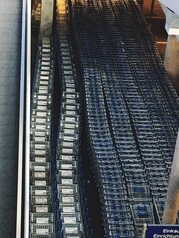The proximity to workplaces and its impact on real estate value

Proximity to workplaces is a crucial factor that not only affects quality of life but also plays a decisive role in real estate value. In the competitive Costa Rican market, understanding how this closeness influences appreciation can be the key to making informed decisions when buying or selling properties. This article will explore how nearby services and strategic location can significantly impact your real estate investment.
The influence of public transportation on property values
The influence of public transportation on property values is a fundamental aspect that is often overlooked when considering proximity to workplaces. Easy and efficient access to public transportation not only improves the mobility of residents but also increases the demand for properties located in those areas. Buyers often prefer homes that allow them to quickly reach their workplaces without solely relying on a personal vehicle. This translates into greater appreciation for properties near train stations, bus stops, or any well-developed public transportation system, as these services are seen as an added attraction.
Additionally, efficient public transportation can contribute to an overall better quality of life. People who use collective transport tend to experience less traffic-related stress and enjoy additional time for personal or family activities. This positive perception can influence purchasing decisions, as many families seek environments where they can enjoy not only access to jobs but also a connected and accessible community. Consequently, properties located near public transportation may achieve faster and sustained appreciation due to this growing demand for more balanced and convenient lifestyles.
2. How emerging labor areas affect real estate demand
Emerging labor areas are redefining the real estate landscape by influencing the demand for properties. As new industries and companies establish themselves in certain regions, these areas begin to attract not only workers but also their families. Proximity to workplaces that offer dynamic and promising job opportunities makes nearby neighborhoods more attractive, which in turn drives up property prices. This creates a cycle where investment in infrastructure and complementary services follows labor growth, further reinforcing real estate value.
Moreover, digital transformation and labor flexibility are driving a new trend: many professionals are seeking to live close to their workplaces to avoid long commutes. This has led to a resurgence in demand for homes strategically located near technology parks or emerging commercial districts. Properties that offer easy access to public transportation and facilities for remote work are also gaining popularity, which is a key factor in their valuation. Consequently, understanding how these changes affect real estate demand can be decisive for those looking to make a smart and sustainable investment in the current market.
3. Essential services: how close should they be?
The proximity to essential services is an aspect that complements the closeness to workplaces, as a home located near schools, hospitals, supermarkets, and public transportation not only improves the quality of life of its occupants but also translates into an increase in real estate value. Potential buyers often prioritize these amenities when looking for a home, meaning that properties in well-served areas tend to maintain their demand even in fluctuating markets. Therefore, a strategic location close to these services can be crucial for maximizing the return on investment.
Additionally, access to basic services directly impacts the perception of the neighborhood. Young families seek environments where their children can easily access education and healthcare, while single professionals value proximity to leisure and transportation options. This dynamic not only affects the initial interest in a property but also its long-term valuation. Investing in areas that offer a good combination of essential services can result in more attractive properties with a lower risk of devaluation due to economic or social changes.
4. The impact of infrastructure on residential areas
The infrastructure in residential areas has a direct impact on the quality of life of its inhabitants and, therefore, on the real estate value of these areas. When there is an adequate network of public transport, access to major roads, and basic services such as supermarkets, schools, and health centers, the convenience of living in that location increases. This not only attracts residents seeking comfort and efficiency in their daily lives but also generates an increase in demand for properties close to these strategic points, thus driving their appreciation in the market.
Additionally, investment in infrastructure can radically transform a residential area. Projects such as park improvements, construction of bike lanes, and modernization of public spaces not only beautify the environment but also create a sense of community that is highly appreciated by potential buyers. Areas that have seen significant improvements tend to experience sustained growth in real estate value due to the added appeal they offer. Therefore, assessing the current and future state of local infrastructure is essential for anyone interested in maximizing their real estate investment.
5. Modern lifestyles: remote work and its effect on the desired location
Remote work has radically transformed work dynamics, allowing many people to perform their activities from the comfort of their homes. This new modality has led to a shift in location preferences, where proximity to workplaces is no longer the sole determining factor when choosing a home. Buyers are now more interested in areas that offer a conducive environment for remote work, such as spacious areas, good internet connectivity, and access to essential services. This change in demand can directly influence the value of properties located in areas with these characteristics, even those situated far from traditional work hubs.
Additionally, this trend towards remote work has led many professionals to seek to move to less urban areas or suburbs that offer a higher quality of life and tranquility. Properties located in natural settings or near recreational resources have gained popularity, becoming attractive options for those looking to balance their work and personal lives. As a result, real estate agents must adapt to this new paradigm and consider how these changes affect property valuation. The added value will depend not only on proximity to the physical workplace but also on the overall appeal of the area and its ability to meet the modern needs of its residents.
6. Comparison between urban and rural areas: pros and cons of each.
The comparison between urban and rural areas reveals a series of pros and cons that can influence the decision to buy or sell properties. In urban areas, proximity to workplaces often translates into higher real estate value due to the constant demand from professionals looking to reduce their commuting times. These environments usually offer a wide range of services, such as efficient public transport, schools, hospitals, and recreational options, which increases their appeal. However, they also present disadvantages like the high cost of living, noise, and traffic congestion, factors that can negatively affect quality of life. On the other hand, rural areas offer a quieter and less hectic lifestyle, with generally lower real estate prices. Buyers seeking larger spaces and contact with nature will find a significant advantage in these areas. However, it is important to consider that the distance to workplaces can result in long daily commutes. This can impact not only time but also the costs associated with transportation. Thus, both urban and rural areas have unique characteristics that must be carefully weighed according to individual needs and priorities when investing in real estate.
7. Strategies to maximize the value of your property through its location
One of the most effective strategies to maximize the value of your property is to recognize and enhance the location in relation to workplaces. Properties located just a few minutes from work areas, such as corporate offices or industrial parks, tend to have constant demand. This translates into a significant increase in interest from potential buyers or tenants, who seek to minimize commuting times and enjoy the convenience of living close to work. Therefore, highlighting the proximity to these places in the sales or rental process can be a decisive factor in increasing perceived value.
Additionally, consider improving access to your property by creating connections with public transportation or main routes. Integration with efficient transportation networks not only increases convenience for residents but also enhances the overall appeal of the area. Investing in small changes that facilitate this access can be economically beneficial in the long term. Finally, it is advisable to stay informed about future urban or commercial developments nearby; these projects can positively influence property value and make your property an even more valuable investment over time.



